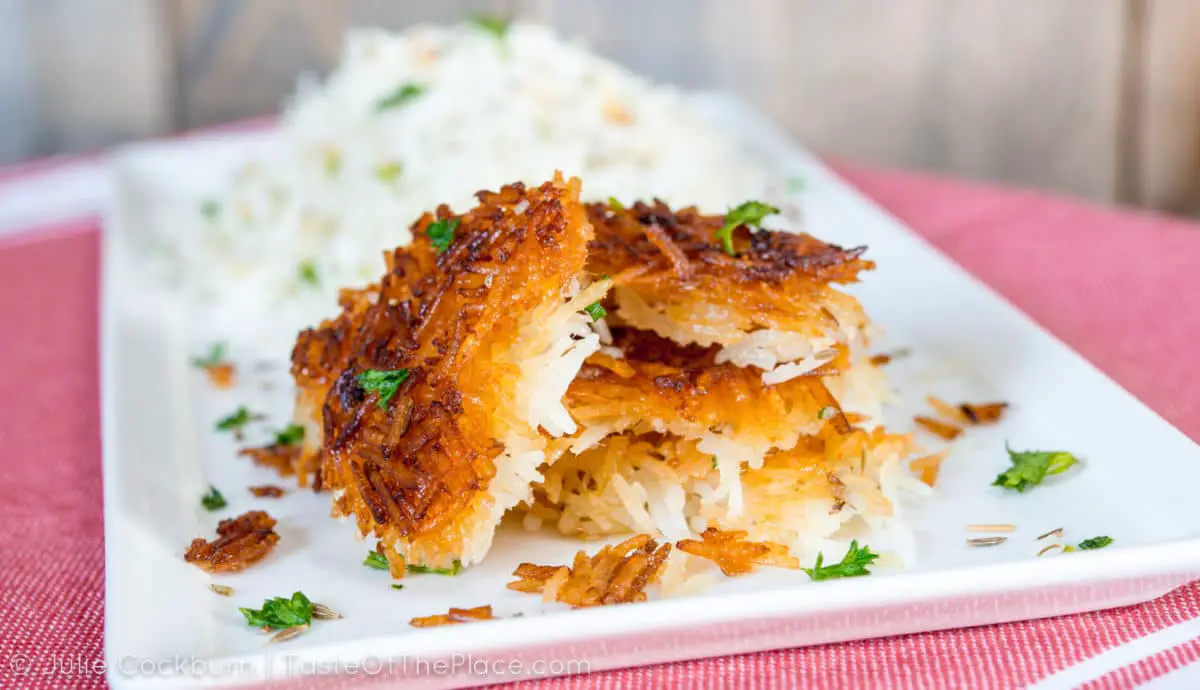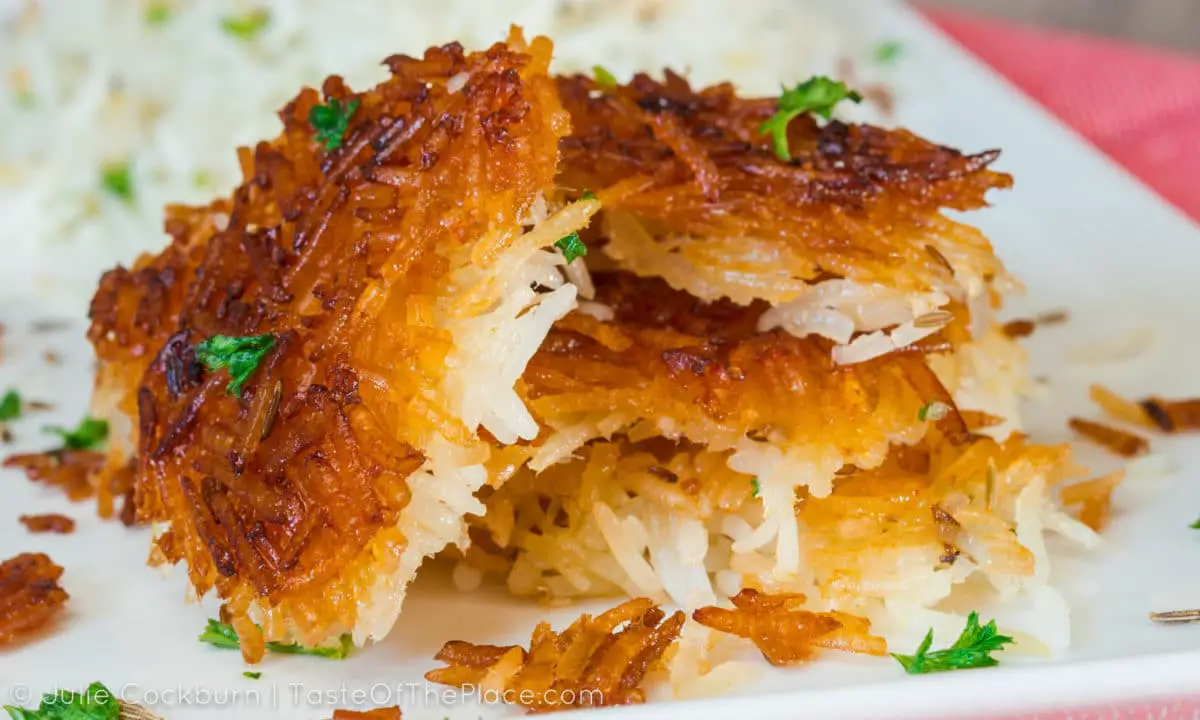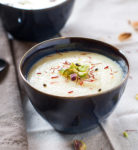This post may contain affiliate links. That means if you click on a link and make a purchase, I may make a small commission at no additional cost to you. Thank you for your support!
Have you ever had one of those culinary experiences that stay with you forever – where everything comes together perfectly – the food is magical, the setting divine, the conversation sparkling (in my case, that usually means the topic is food 😉 )?
Not too long ago, I was lucky enough to have such an experience. It was dinner with family and friends at a beautiful Iranian restaurant near Washington, DC called Yekta Kabobi. Our host, a lovely Iranian woman, guided us to order the perfect combination of appetizers, sides, entrees, and desserts. The fragrances of the spices, the variety of textures, and the beautiful presentation were enchanting – yellow, tart lemons; aromatic, vibrantly green herbs; succulent, purple eggplant; earthy cumin; luxurious saffron – even the ice cream was kissed with that haunting saffron flavor! But what I remember most, and have been wanting to make at home ever since, was a simple plate of golden, buttery, crispy shards of rice.

That crispy rice is called tahdig and is often prepared for special occasions or reserved for honored guests. It is rich, perfectly crisp and crunchy, and, in my opinion, a lot of fun to eat!

I was thrilled when I saw the fine folks over at Cook’s Illustrated perfected and posted a recipe for Persian-style rice with a crispy crust. The Cook’s Illustrated recipe (shared below with permission), while a bit of a process (it is a special occasion dish, after all), is easy to follow with fantastic results. Not only did it produce a wonderfully satisfying, golden, brown, and delicious crust (tahdig), but a rich and flavorful rice pilaf (chelow or polow).
The instructions call for cumin as the main spice, which I thought was quite tasty, but next time, I think I will try saffron. Saffron is the more traditional addition, and I love its haunting, aromatic flavor. By the way, I found both the tahdig and chelow keep well in the fridge for a day or two, so you might as well make the full recipe, even if it’s just for 2 of you. If your tahdig loses some of its crispness in the fridge, simply crisp it again in a hot skillet with a little oil.
I may never be able to exactly reproduce that enchanting evening at the Iranian restaurant, but it sure is fun to find and recreate some of the amazing dishes. Now to find a recipe for saffron ice cream…
Print
Chelow with Tahdig, also know as Persian Style Rice with a Crispy Crust
- Yield: 6 as a side 1x
Description
Crispy, crunchy, and rich, this luxurious Persian rice dish is perfect for a special occasion or celebration.
Ingredients
- 2 cups basmati rice
- Salt
- 1 tablespoon plus 1/4 cup vegetable oil
- 1/4 cup plain Greek yogurt
- 1 1/2 teaspoons cumin seeds
- 2 tablespoons unsalted butter, cut into 8 cubes
- 1/4 cup minced fresh parsley
Instructions
- Place rice in fine-mesh strainer and rinse under cold running water until water runs clear. Place rinsed rice and 1 tablespoon salt in medium bowl and cover with 4 cups hot tap water. Stir gently to dissolve salt; let stand for 15 minutes. Drain rice in fine-mesh strainer.
- Meanwhile, bring 8 cups water to boil in Dutch oven over high heat. Add rice and 2 tablespoons salt. Boil briskly, stirring frequently, until rice is mostly tender with slight bite in center and grains are floating toward top of pot, 3 to 5 minutes (begin timing from when rice is added to pot).
- Drain rice in large fine-mesh strainer and rinse with cold water to stop cooking, about 30 seconds. Rinse and dry pot well to remove any residual starch. Brush bottom and 1 inch up sides of pot with 1 tablespoon oil.
- Whisk remaining ¼ cup oil, yogurt, 1 teaspoon cumin seeds, and ¼ teaspoon salt together in medium bowl. Add 2 cups parcooked rice and stir until combined. Spread yogurt-rice mixture evenly over bottom of prepared pot, packing it down well.
- Stir remaining ½ teaspoon cumin seeds into remaining rice. Mound rice in center of pot on top of yogurt-rice base (it should look like small hill). Poke 8 equally spaced holes through rice mound but not into yogurt-rice base. Place 1 butter cube in each hole. Drizzle 1/3 cup water over rice mound.
- Wrap pot lid with clean dish towel and cover pot tightly, making sure towel is secure on top of lid and away from heat. Cook over medium-high heat until rice on bottom is crackling and steam is coming from sides of pot, about 10 minutes, rotating pot halfway through for even cooking.
- Reduce heat to medium-low and continue to cook until rice is tender and fluffy and crust is golden brown around edges, 30 to 35 minutes longer. Remove covered pot from heat and place on damp dish towel set in rimmed baking sheet; let stand for 5 minutes.
- Stir 2 tablespoons parsley into rice, making sure not to disturb crust on bottom of pot, and season with salt to taste. Gently spoon rice onto serving platter.
- Using thin metal spatula, loosen edges of crust from pot, then break crust into large pieces. Transfer pieces to serving platter, arranging evenly around rice. Sprinkle with remaining 2 tablespoons parsley and serve.
Notes
Notes from Cook’s Illustrated:
“We prefer the nutty flavor and texture of basmati rice, but Texmati or another long-grain rice will work. For the best results, use a Dutch oven with a bottom diameter between 8½ and 10 inches. It is important not to overcook the rice during the parboiling step, as it will continue to cook during steaming. Begin checking the rice at the lower end of the given time range. Do not skip placing the pot on a damp towel in step 7—doing so will help free the crust from the pot. Serve this pilaf alongside stews or kebabs.” – extra tips courtesy of Cook’s Illustrated
- Category: Side
- Cuisine: Persian











Leave a Reply